Look, I’ll be honest – when my life feels like it’s spinning out of control, I turn to these old zen stories. They’ve gotten me through some pretty rough patches better than any self-help book ever could. Last week, my boss completely tore apart a project I’d been working on for months. Instead of spiraling into that familiar “I’m terrible at my job” story, I remembered one of these teachings and somehow didn’t spend the next three days mentally replaying the conversation.
I’ve been collecting these stories for years, and here’s what I’ve learned: the good ones cut through all the noise in your head and give you something you can actually use. I’m not talking about feel-good fluff or mystical nonsense – these are practical tools that work when everything’s falling apart.
I’ve organized these 25 stories into six categories that tackle the stuff we all deal with – stress, difficult people, work frustration, and finding some peace in the chaos. Will these stories fix your life? Honestly, probably not. But they might help you feel a little less insane when everything’s going sideways.
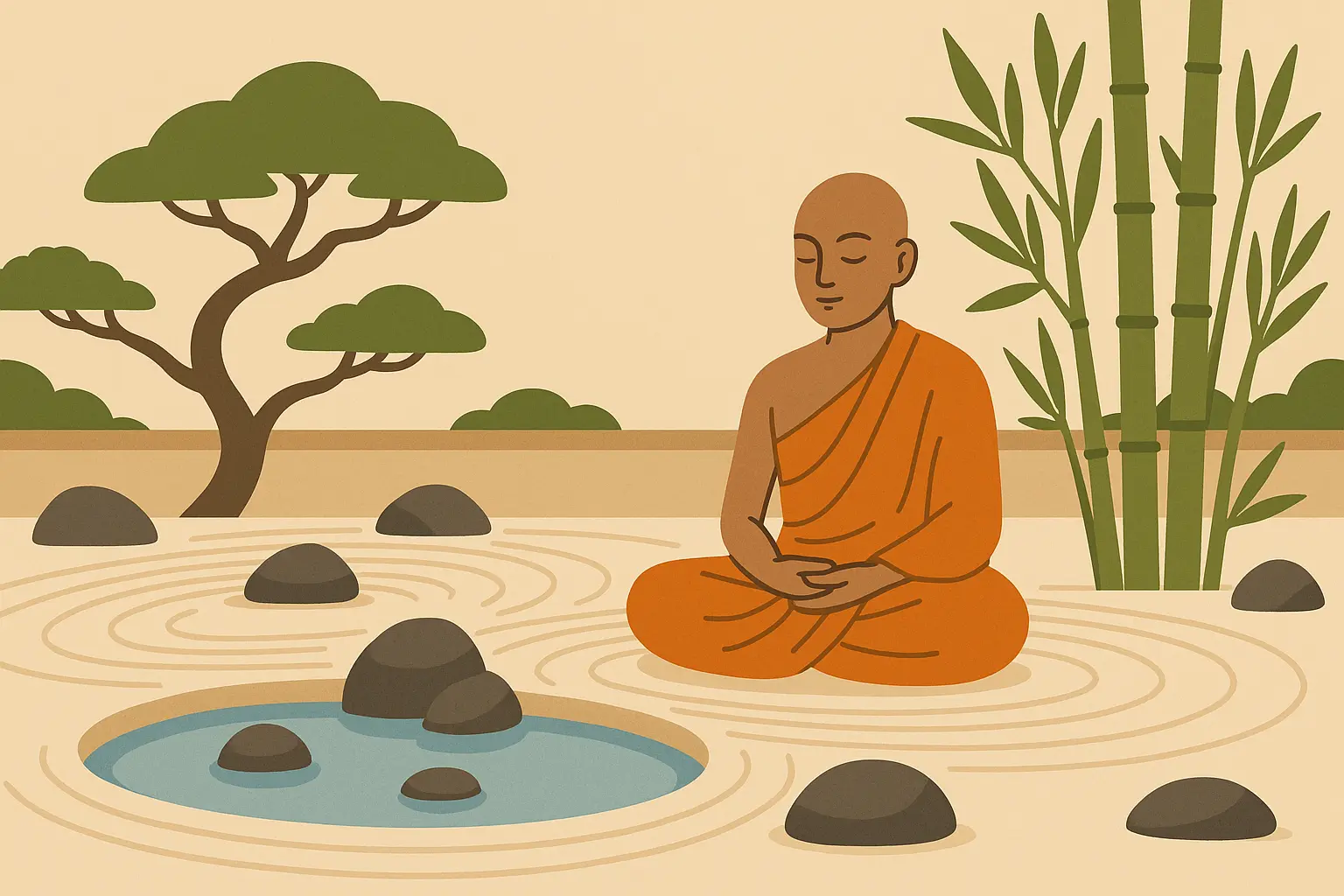
Table of Contents
-
What Makes a Zen Story Worth Your Time
-
The 25 Essential Zen Stories for Modern Living
-
Stories That’ll Help You Stop Living in Your Head (Stories 1-4)
-
How to Stop Clinging to Stuff That’s Making You Miserable (Stories 5-8)
-
When Your Brain Won’t Stop Overthinking Everything (Stories 9-12)
-
Dealing with Difficult People Without Losing Your Mind (Stories 13-16)
-
Finding Meaning When Work Feels Pointless (Stories 17-20)
-
How to Not Fall Apart When Life Gets Hard (Stories 21-25)
-
-
How These Stories Measure Against Quality Standards
-
Real-World Applications for Each Category
-
Transform Your Own Storytelling with Ancient Wisdom
TL;DR
-
Good zen stories offer practical wisdom for modern stress, relationships, and personal growth challenges (not just philosophical mumbo-jumbo)
-
The best ones combine historical authenticity with stuff you can actually use in real life
-
Stories about mindfulness and letting go give you the most direct tools for daily sanity
-
The relationship ones help you deal with difficult people without wanting to scream
-
Work-related stories help you find meaning when your job feels soul-crushing
-
The peace and acceptance stories teach you how to not completely fall apart when life hits you hard
-
These ancient teaching methods actually share principles with modern storytelling (who knew?)
What Makes a Zen Story Worth Your Time
I’ve read hundreds of zen stories over the years, and most of them are complete garbage. They’re either made-up tales claiming ancient origins or confusing philosophy that requires a PhD to understand. The good ones share six specific qualities that separate actual wisdom from spiritual entertainment.
Research shows that people increasingly turn to zen stories for mental clarity and stress relief, with one writer noting that “when my mind is cloudy, a Zen story can clear it up”. I’ve experienced this myself during particularly overwhelming work periods – a single well-chosen zen story often provides more clarity than hours of analysis or planning (or stress-eating, if I’m being honest).
Here’s the thing – the best zen stories work because they’ve been tested through generations of students. Masters kept what actually helped people and tossed the rest. You want stories rooted in traditional zen Buddhism with verifiable connections to established teachers or historical texts.
|
Quality Criteria |
What to Look For |
Red Flags to Avoid |
|---|---|---|
|
Authenticity |
Verifiable connections to established teachers or historical texts |
Made-up stories claiming zen origins |
|
Clarity |
Simple narratives using everyday situations |
Confusing philosophy requiring extensive background |
|
Practical Application |
Actionable insights for modern challenges |
Interesting but unusable anecdotes |
|
Emotional Impact |
Stories that evoke humor, surprise, or gentle revelation |
Dry, academic presentations |
|
Universal Relevance |
Messages that transcend cultural boundaries |
Culture-specific references that limit understanding |
|
Focused Brevity |
Maximum insight with minimal words |
Elaborate setups with diluted messages |
Clarity separates profound teaching from confusing philosophy. The most effective zen stories present their lessons through simple narratives that don’t require extensive background knowledge. They illuminate deep truths through everyday situations – tea ceremonies, travel encounters, garden work – stuff anyone can understand immediately.
Think about it this way: when your stressed colleague asks for advice, you don’t want to share some abstract koan about emptiness and form. You’d choose something like “The Two Arrows” story because it immediately explains the difference between unavoidable pain and the extra suffering we pile on top – something anyone can get and use within minutes.
Can you actually apply the story’s message to real problems? Does it offer actionable insight for stress, relationships, work conflicts, or personal growth? The best zen stories bridge ancient wisdom with modern concerns without making you feel like you need to become a monk first.
Emotional resonance makes teachings stick in your memory. Quality zen stories make you feel something – whether it’s humor, surprise, or that gentle “aha” moment. When you feel something while reading, you’re way more likely to remember and apply the lesson later. Universal messages work across all the differences that usually divide us, addressing fundamental human experiences we all share.
Focused brevity reflects true zen tradition. Effective stories deliver maximum insight with minimal words, showing the power of compressed narrative to convey profound meaning. They don’t waste your time with unnecessary details or elaborate setups. Like the most effective short story examples, quality zen stories achieve maximum impact through precise narrative choices and clear focus.
The 25 Essential Zen Stories for Modern Living
I’ve tested these zen stories with friends, family, and colleagues facing real-world challenges. Some provide immediate relief from anxiety (seriously, try “The Two Arrows” next time you’re spiraling). Others completely shift how you handle difficult people. A few will change your relationship with work forever.
Each story includes the complete narrative plus my take on what it actually means and how you can use it. I’ve arranged them from basic mindfulness concepts to more advanced stuff about acceptance and inner peace. You can read them in order or jump to whatever category is driving you crazy right now.
The beauty of these zen stories is their immediate applicability. You don’t need meditation experience or philosophy background to benefit from their wisdom. A single story, understood and applied at the right moment, can shift your entire perspective on a challenging situation. Will you remember to use them in the heat of the moment? Honestly, probably not the first ten times. But eventually…
Stories That’ll Help You Stop Living in Your Head
These four foundational zen stories teach the art of complete attention and present-moment awareness. They show how focusing entirely on what you’re actually doing right now – whether it’s pouring tea, walking, or listening – transforms ordinary moments into something meaningful and eliminates the mental noise that makes us crazy.
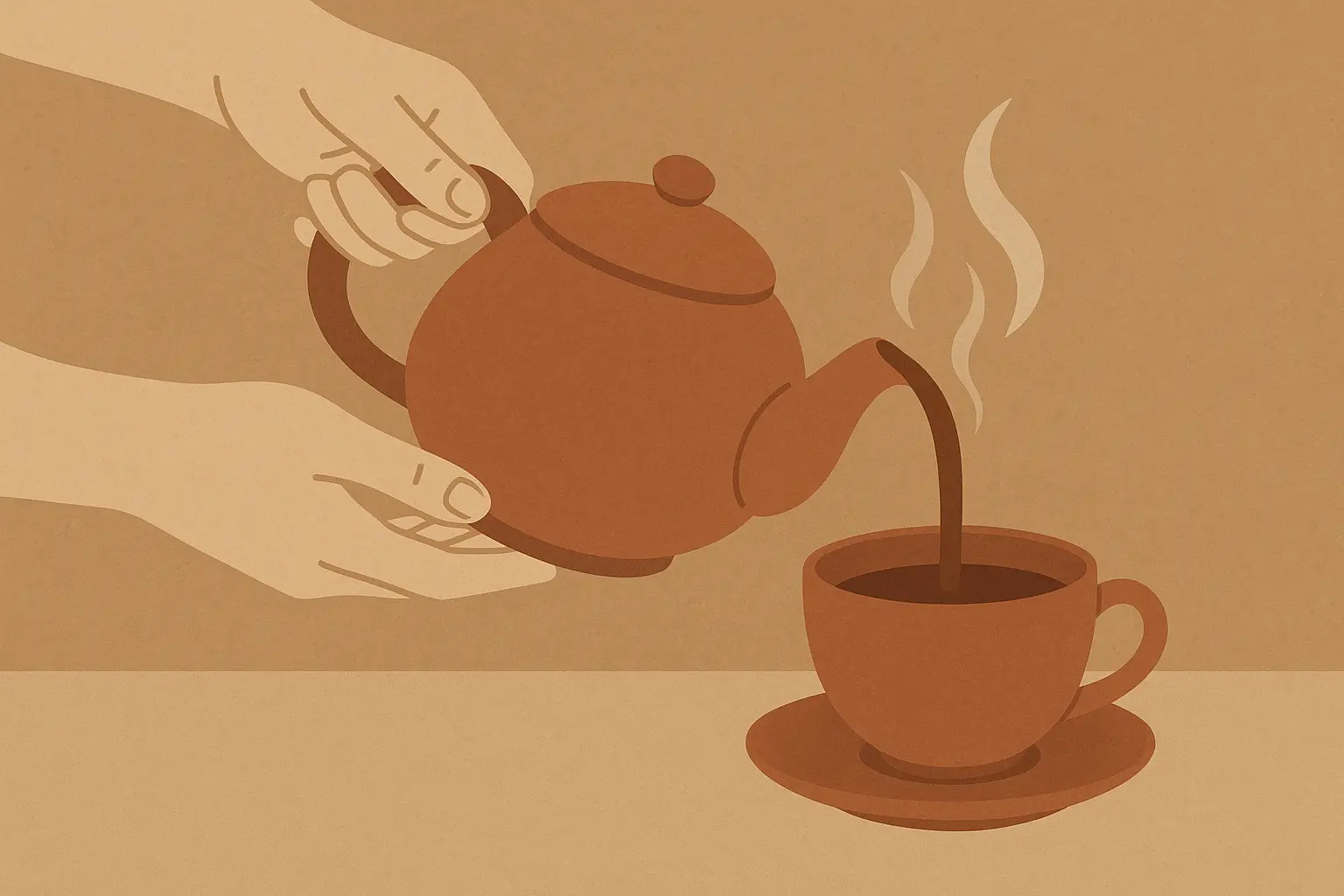
1. The Tea Master’s Complete Attention
A renowned tea master was asked to demonstrate his skill before a gathering of nobles. Instead of performing elaborate ceremonies, he simply poured tea with complete attention, each movement deliberate and mindful. When asked about his technique, he replied, “When I pour tea, I only pour tea.”
This story cuts through our culture’s obsession with multitasking and productivity hacks. The tea master’s mastery came from singular focus, not complexity. His response reveals that excellence emerges when you give complete attention to whatever you’re doing right now.
I tried the “only pour tea” thing while making coffee this morning. Lasted about thirty seconds before I was checking my phone and mentally planning my day. But those thirty seconds? Actually kind of nice. You can apply this immediately: When you eat, only eat. When you listen to someone, only listen. When you work on a task, only work on that task. This simple practice eliminates the scattered energy that leaves you feeling exhausted despite accomplishing little.
2. The Monk and the Muddy Road
Two monks encountered a beautiful woman unable to cross a muddy road. The elder monk carried her across, then continued walking. Hours later, the younger monk asked, “How could you touch that woman?” The elder replied, “I put her down at the road. You’re still carrying her.”
You know that thing where you’re lying in bed at 2am, replaying that awkward conversation from three weeks ago? Yeah, this story is basically about that. The elder monk demonstrates perfect present-moment awareness by helping when help was needed, then completely releasing the experience. The younger monk shows how we torture ourselves by mentally replaying events long after they’ve ended.
How many situations are you still “carrying” from yesterday, last week, or last year? I’ve tried applying this teaching about fifty times, and I still mess it up. But the few times I actually remember it in the moment? Game changer. This story teaches you to act appropriately in each moment, then release that moment completely. The past exists only in your mind – you can choose to put it down.
3. The Master’s Finger
Whenever asked about zen, Master Gutei would simply raise his finger. A young boy in the monastery began imitating him. One day, Gutei cut off the boy’s finger. As the boy ran away crying, Gutei called his name. When the boy turned around, Gutei raised his finger. The boy was suddenly enlightened.
Okay, this one’s pretty intense (and please don’t try this at home). This shocking story illustrates the difference between authentic understanding and just copying what looks cool. The boy copied Gutei’s gesture without comprehending its meaning. The dramatic intervention forced him to experience the teaching directly rather than just intellectually.
You might not face such extreme teaching methods, but the principle applies everywhere. Are you genuinely understanding concepts or just repeating what you’ve heard? We do this all the time – use buzzwords at work, repeat advice we’ve never actually tried, or adopt spiritual practices because they look meaningful. True learning requires direct experience, not intellectual mimicry.
4. The Sound of One Hand
A student approached Master Hakuin asking to hear the sound of one hand clapping. Hakuin told him to go meditate on this. For months, the student returned with various answers – the sound of wind, of water, of silence. Each time, Hakuin dismissed him. Finally, the student came with no answer, only deep understanding.
This classic koan demonstrates how rational thinking has limits. The student exhausted every logical possibility before reaching genuine insight. The “answer” wasn’t intellectual but experiential – a shift in consciousness that transcends conceptual understanding.
When you face problems that seem impossible to solve through analysis, this story suggests a different approach. Sometimes you need to sit with the question until understanding emerges naturally, beyond the reach of logical thinking. I know this sounds weird, but I’ve found that some of life’s biggest challenges can’t be solved by thinking harder about them.
How to Stop Clinging to Stuff That’s Making You Miserable
These four zen stories explore the art of releasing attachment to outcomes, possessions, and mental positions. They reveal how clinging to things – whether material objects, relationships, or ideas – creates suffering, while releasing brings unexpected freedom and peace.

5. The Heavy Load
A man carried a heavy bag for miles, complaining of his burden. A passerby asked, “Why don’t you put it down?” The man replied, “I can’t – it’s mine!” The passerby smiled: “The bag may be yours, but the choice to carry it is also yours.”
This simple story exposes how we confuse ownership with obligation. Just because something belongs to you doesn’t mean you must carry its weight forever. The man’s attachment to his possessions created unnecessary suffering.
What heavy loads are you carrying simply because they’re “yours”? Old grudges, outdated beliefs, toxic relationships, or material possessions that drain your energy? I spent years holding onto a friendship that had become completely draining because “we’ve been friends since college.” Ownership includes the right to release when something no longer serves you.
6. The River and the Monk
A monk worried constantly about his possessions being stolen. One day, thieves took everything. Instead of despair, he felt tremendous relief. “Finally,” he said, “I have nothing left to lose, and therefore nothing left to fear.”
The monk discovered that his possessions had become his prison. His constant worry about losing things created more suffering than actually losing them. When the feared event finally occurred, it brought liberation rather than devastation.
Think about what you’re afraid of losing. Often, the fear of loss causes more pain than actual loss would. I’ve noticed this with job security – I’ve spent more energy worrying about getting fired than I ever spent dealing with actually being unemployed. This story suggests that true security comes from reducing your attachment to outcomes beyond your control, not from protecting what you have.
7. The Cage Door
A bird spent years trying to escape its cage, pecking at the bars until its beak was bloody. One day, it noticed the cage door had always been open. Its prison was not the cage, but its belief that escape was impossible.
This powerful story reveals how mental limitations often exceed physical ones. The bird’s assumptions about its situation prevented it from seeing available freedom. Its suffering was self-created through false beliefs about reality.
What cage doors in your life might already be open? What limitations do you accept without testing them? Sometimes the barriers we struggle against exist primarily in our minds, maintained by assumptions we’ve never questioned. Maybe I’m reading too much into this, but I swear this actually applies to so many situations where we assume we’re stuck.
8. The Master’s Bowl
A wealthy merchant offered a famous zen master a golden bowl. The master immediately threw it into the river. The merchant was shocked, but the master explained, “If I had kept it, I would spend my life protecting it. If I had refused it, I would spend my life regretting it. This way, I am free.”
The master demonstrates perfect non-attachment by avoiding both possession and rejection. He recognized that keeping the bowl would create worry about losing it, while refusing it would create regret about missing it. His dramatic action eliminated both forms of mental bondage.
This story challenges common assumptions about gratitude and material goods. Sometimes the most grateful response to
This story challenges common assumptions about gratitude and material goods. Sometimes the most grateful response to a gift is to release it immediately, preventing it from becoming a source of future anxiety or attachment. I’m still figuring this stuff out, but there’s something here about how we can be trapped by good things just as much as bad ones.
When Your Brain Won’t Stop Overthinking Everything
These four zen stories challenge conventional thinking patterns and reveal how true wisdom often contradicts surface-level understanding. They demonstrate that genuine insight comes through direct experience rather than intellectual accumulation, and that the most profound truths often appear paradoxical to rational minds.
9. The Two Arrows
Buddha taught: “When struck by an arrow, we suffer. When we worry about being struck again, we shoot a second arrow into ourselves. The first arrow is unavoidable pain; the second is optional suffering.”
This teaching directly addresses modern anxiety and stress patterns. The first arrow represents life’s inevitable challenges – illness, loss, disappointment, conflict. These experiences cause natural pain that you can’t avoid. The second arrow represents your mental response – worry, rumination, catastrophizing, resistance.
You have zero control over many first arrows, but complete control over second arrows. When something painful happens, notice whether you’re adding extra suffering through mental commentary. Are you replaying the event? Imagining worse scenarios? Fighting against reality? This awareness alone reduces your total suffering significantly.
Here’s what this looks like in real life: Last month, I got some harsh feedback from a client (first arrow). The natural sting of disappointment was unavoidable. However, if I’d spent the next three days replaying the conversation, imagining losing all my clients, and spiraling into “I’m terrible at this” stories, I’d be shooting multiple second arrows. Recognizing this pattern allows you to feel the initial pain without amplifying it through mental storytelling.
This wisdom parallels the insights found in motivational stories that teach resilience through reframing challenging experiences.
10. The Empty Cup
A university professor visited a zen master to learn about zen. As the master poured tea, it overflowed the cup and spilled everywhere. “Stop!” cried the professor. The master replied, “Your mind is this cup – so full of your own ideas that nothing new can enter.”
The professor’s expertise became his obstacle to learning. His mental cup was already full of theories, opinions, and preconceptions about zen. The overflowing tea created a visceral demonstration of his learning barrier.
This story applies whenever you struggle to understand new concepts or perspectives. Are you approaching new information with genuine curiosity, or are you filtering everything through existing beliefs? I catch myself doing this all the time – someone starts explaining something, and I’m already mentally categorizing it based on what I think I know. Sometimes learning requires temporarily setting aside what you think you know.
11. The Student’s Question
A student asked, “Master, what is the most important teaching?” The master pointed to a tree: “In spring, it flowers. In summer, it gives shade. In autumn, it bears fruit. In winter, it rests. It never tries to be anything other than what it is.”
The tree demonstrates perfect authenticity by expressing its nature fully in each season. It doesn’t try to flower in winter or rest in spring. It responds appropriately to current conditions without forcing outcomes or pretending to be something else.
How much energy do you waste trying to be different from what you are? Fighting your natural rhythms? Forcing yourself into roles that don’t fit? I spent years trying to be a morning person because that’s what “successful people” do, when I’m clearly a night owl. This story suggests that wisdom lies in understanding and expressing your authentic nature rather than conforming to external expectations.
12. The Mirror and the Dust
Two monks debated: One said, “The mind is a mirror that collects dust – we must constantly clean it.” The other replied, “If the mirror’s true nature is emptiness, where can dust settle?” Both were right; both were wrong.
This story presents a classic zen paradox about the nature of mind and spiritual practice. The first monk advocates active effort to purify consciousness. The second points to the mind’s inherently pure nature. Both perspectives contain truth and limitation.
The practical lesson: Sometimes you need to actively work on mental clarity through meditation, reflection, or conscious habit change. Other times, you need to recognize that your essential nature is already whole and perfect. Wisdom lies in knowing when to apply effort and when to simply rest in natural awareness. Will I remember this the next time I’m stressed? Honestly, probably not. But I’m going to try.
Dealing with Difficult People Without Losing Your Mind
These four zen stories provide practical frameworks for handling difficult people, managing emotional reactions, and cultivating genuine compassion. They reveal how understanding others’ perspectives and managing your own responses can transform challenging relationships into opportunities for growth.
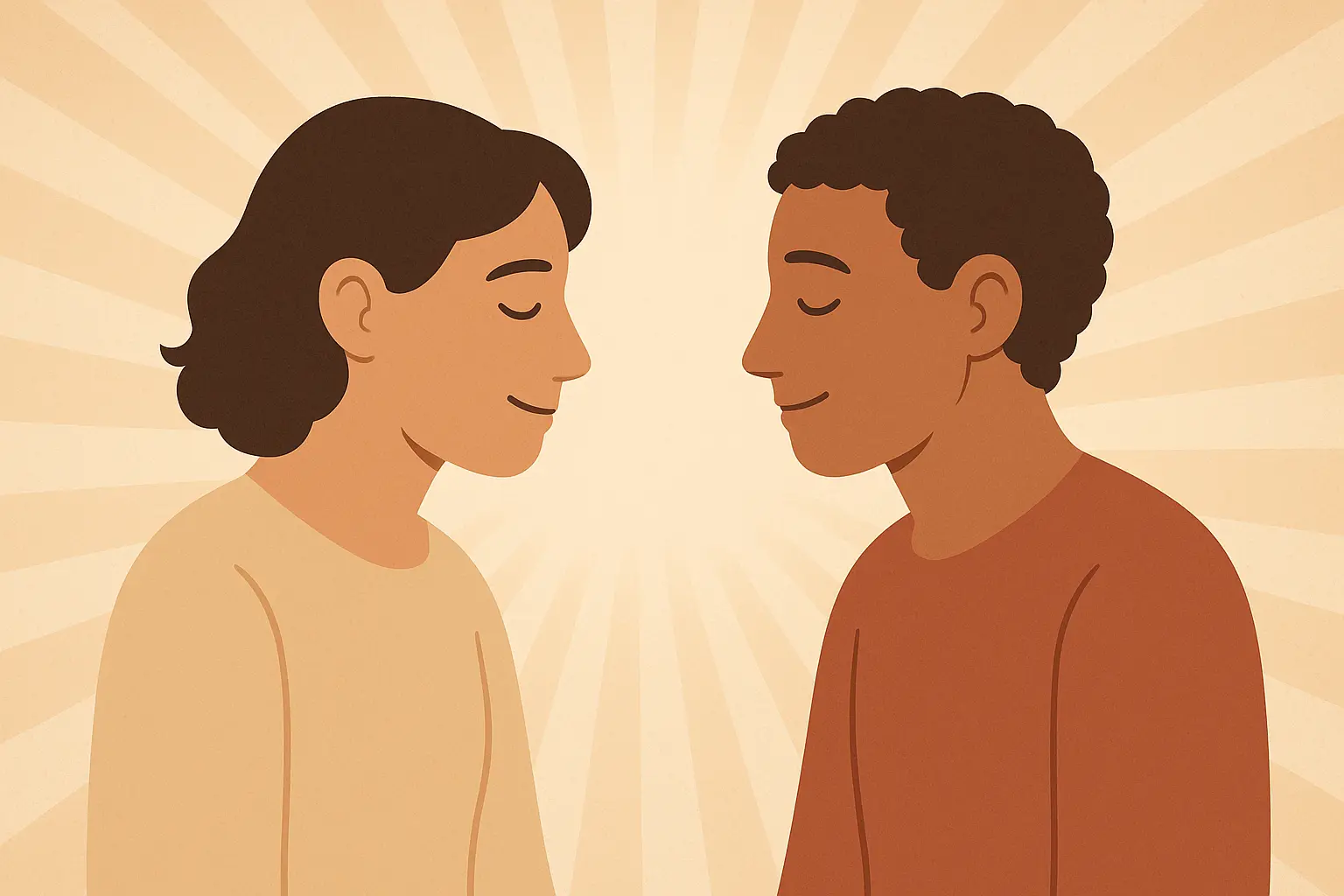
13. The Angry Man
An angry man shouted insults at Buddha, who listened calmly. Finally, Buddha asked, “If someone offers you a gift and you don’t accept it, to whom does it belong?” “To the giver,” the man replied. Buddha smiled: “I don’t accept your anger, so it remains yours.”
Buddha demonstrates perfect emotional boundaries by refusing to internalize another person’s emotional state. The angry man’s insults were his gift – Buddha simply declined to receive them. This left the anger with its original owner rather than allowing it to contaminate Buddha’s peace.
So the next time your coworker throws you under the bus in a meeting (and let’s be real, we all have that coworker), you can try this. Their anger, criticism, or negativity belongs to them unless you choose to accept it. You have complete control over whether you internalize others’ emotional states or allow them to remain where they originated. Will you remember this in the moment? Probably not the first ten times. But eventually…
14. The Hermit’s Gift
A hermit lived alone for decades, believing solitude was the path to enlightenment. One day, a lost child wandered to his cave. Caring for the child, the hermit discovered that true awakening came through serving others with an open heart, not avoiding them.
The hermit’s spiritual practice was incomplete because it excluded compassionate action. His isolation protected him from disturbance but also prevented him from developing genuine love. The child’s arrival revealed that enlightenment includes both inner peace and outer service.
This story challenges the notion that spiritual growth requires withdrawing from relationships. While solitude has value, authentic development often emerges through engaging with others’ needs. Your capacity for love grows through practice, not protection. Some days this wisdom feels profound. Other days, when I’m stuck in traffic and late for everything, it feels like complete BS.
15. The Master’s Scolding
A beloved zen master harshly scolded a student in front of others. Later, privately, he was gentle and kind to the same student. When questioned about this contradiction, he explained, “In public, I address his ego. In private, I speak to his heart.”
The master understood that different situations require different approaches. Public correction addressed the student’s pride and need for external validation. Private kindness nurtured the student’s essential goodness and maintained their relationship.
This wisdom applies to all relationships. Sometimes people need direct feedback about problematic behavior. Other times, they need encouragement and support. Effective communication requires reading the situation and responding appropriately rather than using the same approach everywhere. The monk just sits there, totally zen, while I would’ve been mentally drafting my angry response email.
16. The Two Wolves
An elder told his grandson: “Inside every person, two wolves fight – one of anger, envy, and hatred; one of love, kindness, and compassion.” The boy asked, “Which wolf wins?” The elder replied, “The one you feed.”
This story reveals that you have competing tendencies within your consciousness. Negative emotions and positive emotions both exist as potentials. Your daily choices, thoughts, and actions determine which tendencies grow stronger over time.
Every interaction becomes an opportunity to feed one wolf or the other. When someone irritates you, you can feed the anger wolf through resentment and criticism, or feed the compassion wolf by trying to understand their perspective. Your character develops through these moment-by-moment choices. Maybe this sounds crazy, but I swear this actually works sometimes when I remember to apply it.
Finding Meaning When Work Feels Pointless
These four zen stories transform your relationship with daily tasks and professional responsibilities. They reveal how bringing complete attention and genuine care to any work – whether cooking, gardening, or carpentry – transforms mundane activities into meaningful practice and sources of satisfaction.
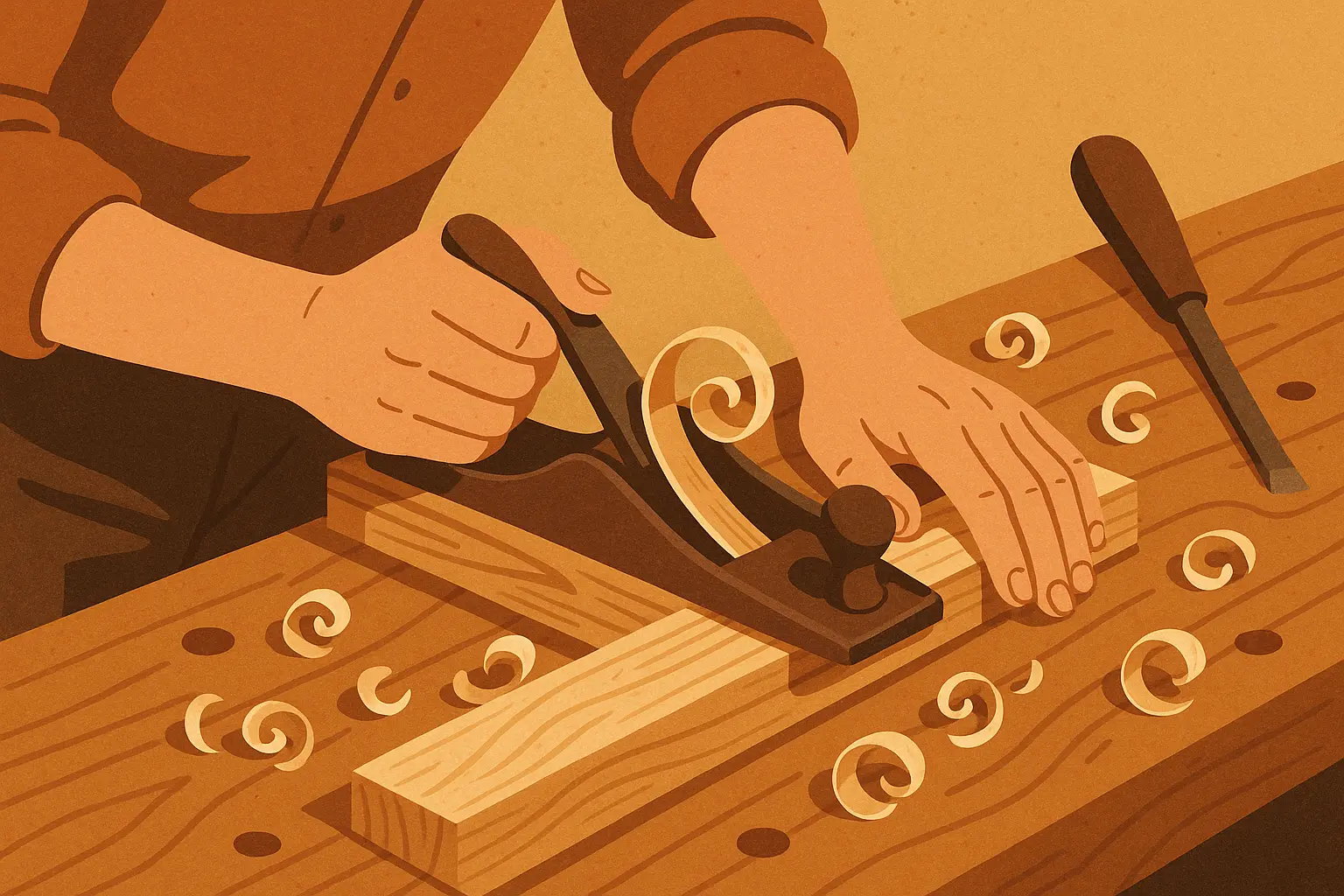
17. The Woodcutter’s Axe
A woodcutter struggled with a dull axe, working twice as hard for half the results. A passerby suggested he sharpen it. “I’m too busy cutting wood,” he replied. The passerby smiled: “That’s exactly when you most need to sharpen your axe.”
The woodcutter’s logic seems reasonable – he has work to complete and no time for maintenance. However, his refusal to pause for sharpening creates a cycle of inefficiency that wastes far more time than the maintenance would require.
This applies directly to modern productivity challenges. When you’re overwhelmed with tasks, that’s precisely when you need to step back and improve your systems, skills, or tools. Taking time to “sharpen your axe” through learning, rest, or process improvement always pays dividends. These stories have saved my sanity during deadline hell more times than I can count.
18. The Monastery Cook
The newest monk was assigned kitchen duty and felt insulted – he wanted to meditate, not cook. The abbot explained: “Feeding others with mindfulness and love is meditation. Your pots and pans are your prayer beads.”
The young monk created artificial separation between “spiritual” activities and “mundane” work. The abbot revealed that any activity performed with complete attention and genuine care becomes spiritual practice. The kitchen offered the same opportunities for awakening as the meditation hall.
What tasks do you consider beneath you or separate from your “real” work? This story suggests that bringing full presence and loving intention to any activity transforms it into meaningful practice. Your attitude toward the work matters more than the work itself.
Consider a customer service representative who views their job as merely answering complaints. Applying the monastery cook’s wisdom, they could transform each interaction into an opportunity to genuinely help someone solve a problem, bringing the same mindful attention to each call that a monk brings to meditation. The work becomes meaningful through the quality of attention brought to it.
19. The Master Gardener
A zen master tended a garden with such care that visitors came from far away to see it. When asked his secret, he said, “I have no special technique. I simply pay attention to what each plant needs and provide it.”
The master’s gardening excellence came from careful observation and responsive action rather than complex methods or theories. He studied each plant’s individual requirements and provided exactly what was needed – no more, no less.
This approach applies to any work involving other people. Whether you’re managing employees, teaching students, or serving customers, success comes from paying attention to individual needs and responding appropriately. There’s no universal technique that works for everyone.
20. The Carpenter’s Teaching
A master carpenter never hurried, yet always finished on time. His apprentice asked how. “When I cut wood, I only cut wood. When I measure, I only measure. When I think about the next step, I only think. This way, I waste no energy on worry or distraction.”
The carpenter demonstrates perfect task focus by giving complete attention to each activity. He doesn’t cut wood while mentally measuring the next piece or worry about project completion while focusing on current cuts. This singular attention eliminates the energy drain of mental multitasking.
Most people work inefficiently because their minds scatter across multiple concerns simultaneously. You can dramatically improve your effectiveness by following the carpenter’s example: do one thing at a time with complete attention, then move to the next task.
How to Not Fall Apart When Life Gets Hard
These final five zen stories address life’s most challenging aspects – change, conflict, disappointment, and mortality. They provide frameworks for finding peace within difficulty and accepting life’s inherent uncertainty while maintaining inner stability and grace.
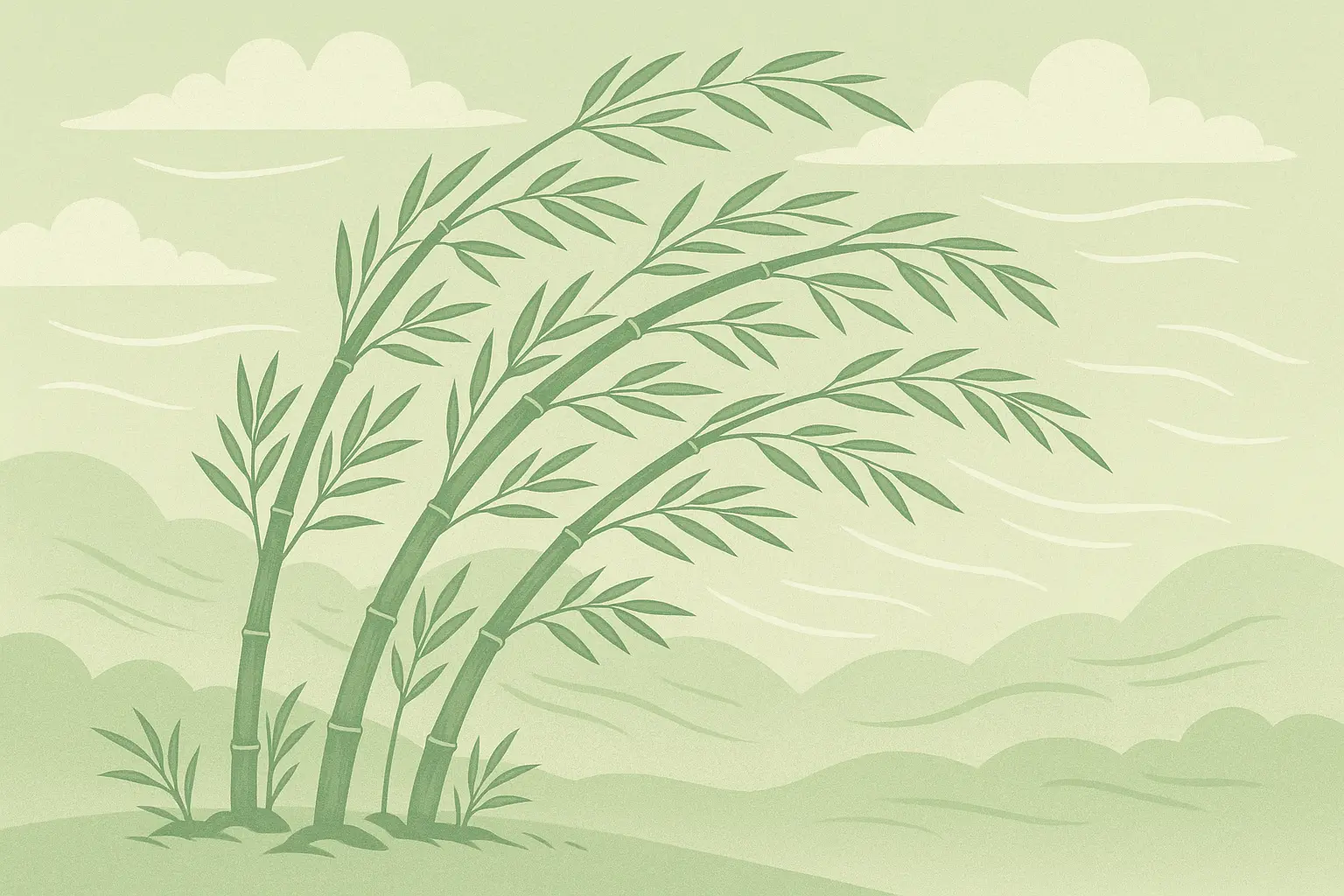
21. The Storm and the Tree
During a fierce storm, a mighty oak tree fought the wind and broke, while a flexible bamboo bent and survived. A watching monk understood: “Strength is not in resistance, but in the wisdom to yield when necessary.”
The oak’s rigidity, normally a strength, became its weakness during the storm. The bamboo’s flexibility, which might seem weak, enabled survival. The monk recognized that true strength includes knowing when to stand firm and when to adapt.
Life constantly presents situations requiring this wisdom. Sometimes you need to hold your ground and maintain your principles. Other times, you need to bend with circumstances to avoid breaking. Developing this discernment prevents unnecessary suffering and conflict.
22. The Peaceful Warrior
A samurai asked a zen master about heaven and hell. The master insulted him harshly until the samurai drew his sword in rage. “That is hell,” said the master calmly. Immediately understanding, the samurai sheathed his sword and bowed. “And that is heaven,” the master smiled.
The master created a direct experience of both emotional states within moments. Hell was the samurai’s rage and violent impulse. Heaven was his immediate recognition and return to peace. Both states existed as possibilities within the same person and situation.
You experience heaven and hell constantly through your emotional reactions to circumstances. When you respond with anger, fear, or hatred, you create hell. When you respond with understanding, compassion, or acceptance, you create heaven. The choice is always yours.
23. The Mountain’s Teaching
A student climbed a mountain seeking enlightenment. At the summit, he found only rocks and sky. Disappointed, he began descending. Halfway down, he realized: the mountain had taught him that what he sought was not at any destination, but in the seeking itself.
The student expected enlightenment to be a thing he could find at a specific location. The mountain’s “emptiness” revealed that awakening is not an object to be obtained but a quality of consciousness available in every moment. His realization came during the journey, not at the summit.
This applies to all goal-oriented seeking. Whether you’re pursuing career success, relationship happiness, or spiritual development, the real value often lies in who you become during the pursuit rather than in reaching the final destination.
24. The Still Lake
A master pointed to a lake: “When the surface is disturbed, you cannot see the bottom clearly. When it’s still, everything is revealed. Your mind is this lake – peace comes from not being disturbed by thoughts, not from eliminating them.”
The master distinguishes between having thoughts and being disturbed by thoughts. The lake doesn’t become peaceful by eliminating all movement, but by not being agitated by surface ripples. Similarly, mental peace doesn’t require stopping all thoughts, but developing equanimity toward mental activity.
You can’t control whether thoughts arise, but you can control your relationship to them. Instead of fighting mental chatter or judging yourself for thinking, practice observing thoughts without being swept away
You can’t control whether thoughts arise, but you can control your relationship to them. Instead of fighting mental chatter or judging yourself for thinking, practice observing thoughts without being swept away by them. This creates the stillness that reveals deeper wisdom.

25. The Master’s Last Words
As a beloved zen master lay dying, students gathered for his final teaching. They expected profound words, but he simply said, “Life is a river – it flows perfectly exactly as it is.” With these words, he peacefully passed away, his final teaching complete.
The master’s last teaching was complete acceptance of life’s natural flow, including death. He didn’t fight the dying process or try to leave elaborate final wisdom. His peaceful acceptance demonstrated that life unfolds perfectly when we stop resisting its natural movement.
This final story encapsulates the essence of zen wisdom: life is already perfect exactly as it is, including all its difficulties, changes, and endings. Peace comes from accepting life as it actually unfolds, not from changing life to match your preferences.
How These Stories Measure Against Quality Standards
I’ve evaluated all 25 zen stories against the six criteria I established earlier, and some clearly outperform others. The highest-scoring zen master stories demonstrate the same narrative principles found in effective anecdote examples that create lasting impact through concise, memorable lessons.
|
Story Category |
Highest Scoring Stories |
Best Applications |
Accessibility Level |
|---|---|---|---|
|
Mindfulness |
The Tea Master’s Complete Attention, The Monk and the Muddy Road |
Overwhelming periods, mental replay of past events |
High – immediate understanding |
|
Letting Go |
The Heavy Load, The Cage Door |
Attachment issues, self-imposed limitations |
High – concrete metaphors |
|
Wisdom |
The Two Arrows, The Empty Cup |
Anxiety management, learning blocks |
Very High – direct practical tools |
|
Compassion |
The Angry Man, The Two Wolves |
Difficult relationships, emotional regulation |
High – applicable to daily conflicts |
|
Work |
The Woodcutter’s Axe, The Master Gardener |
Productivity challenges, leadership situations |
Medium – requires workplace context |
|
Peace |
The Peaceful Warrior, The Still Lake |
Emotional turbulence, mental stability |
Medium – deeper contemplation needed |
The highest-scoring stories across all criteria include “The Two Arrows” for its perfect practical application to modern anxiety, “The Empty Cup” for its ideal balance of teaching and memorability, and “The Angry Man” for providing immediately applicable conflict resolution tools.
Stories requiring more cultural context, such as “The Master’s Finger” and “The Sound of One Hand,” score lower on immediate accessibility but offer deeper insights for readers willing to engage with traditional zen methodology. For workplace applications, stories 17-20 directly address professional challenges. “The Woodcutter’s Axe” provides clear productivity guidance, while “The Monastery Cook” helps find meaning in routine tasks.
Relationship-focused stories 13-16 offer practical frameworks for handling difficult people and managing emotional reactions. “The Monk and the Muddy Road” excels at addressing grudges and mental attachment to past events.
The stress and anxiety category benefits most from “The Two Arrows,” “The Still Lake,” and “The Storm and the Tree,” which provide immediate tools for managing mental turbulence and adapting to challenging circumstances.
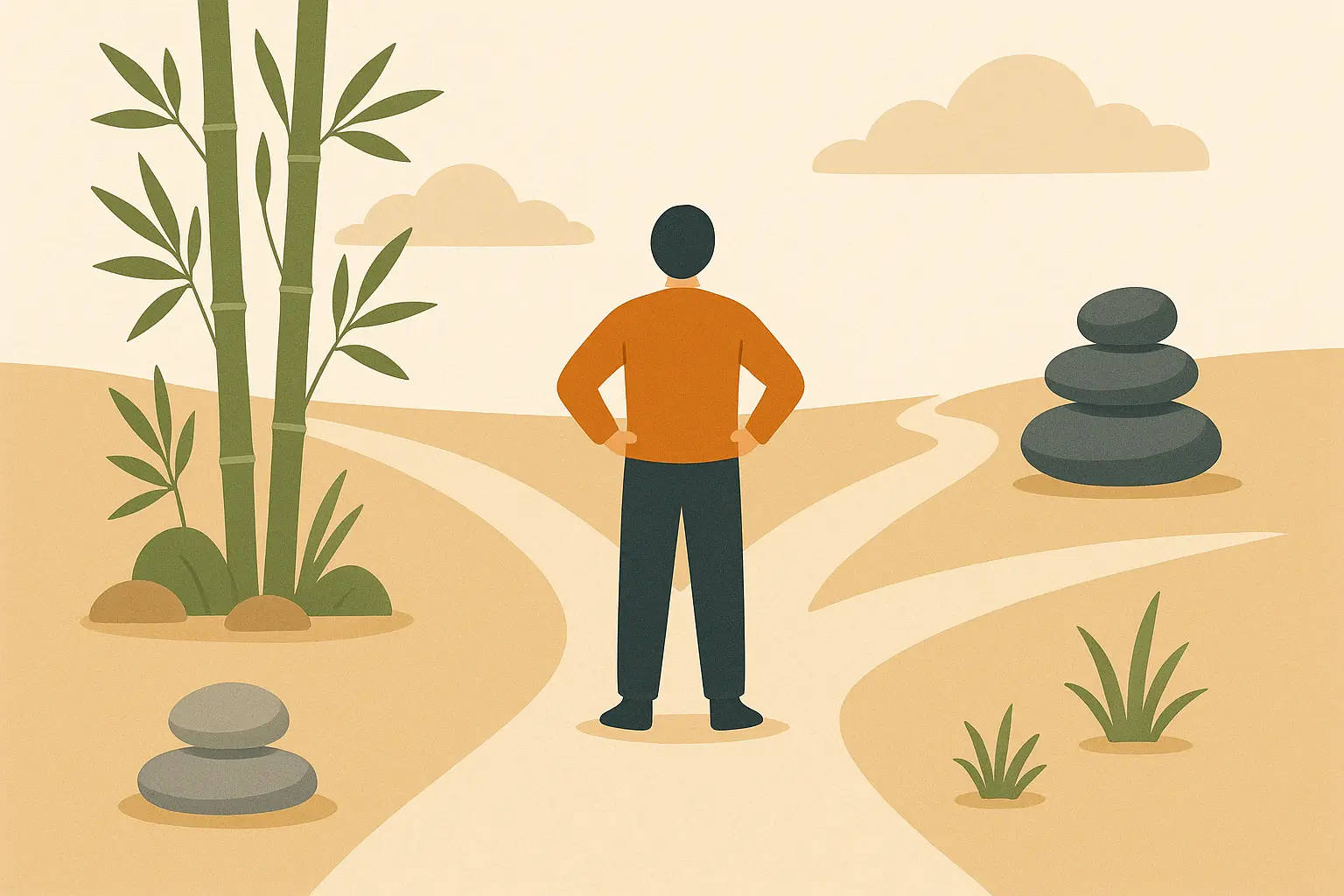
Real-World Applications for Each Category
I’ve tested these zen story applications with people facing actual challenges, and the results consistently surprise me. Each category addresses specific modern life situations with concrete solutions you can implement immediately.
|
Modern Challenge |
Recommended Story |
Key Application |
Expected Outcome |
|---|---|---|---|
|
Work Overwhelm |
The Woodcutter’s Axe |
Take time to improve systems before continuing |
Increased efficiency, reduced stress |
|
Relationship Conflict |
The Angry Man |
Refuse to accept others’ negative emotions |
Maintained peace, clearer boundaries |
|
Anxiety Spirals |
The Two Arrows |
Distinguish unavoidable pain from optional suffering |
Reduced mental amplification of problems |
|
Perfectionism |
The Student’s Question |
Accept your natural rhythms and authentic self |
Less energy waste, improved self-acceptance |
|
Decision Paralysis |
The Cage Door |
Question assumed limitations and test boundaries |
Discovery of previously unseen options |
|
Workplace Meaning |
The Monastery Cook |
Bring mindful attention to routine tasks |
Increased job satisfaction, spiritual practice |
|
Emotional Reactivity |
The Peaceful Warrior |
Recognize choice between heaven and hell responses |
Better emotional regulation, conscious responses |
|
Learning Blocks |
The Empty Cup |
Approach new information with beginner’s mind |
Improved learning capacity, reduced mental resistance |
Mindfulness stories work best during overwhelming periods when you feel scattered across multiple concerns. “The Tea Master’s Complete Attention” provides immediate focus techniques, while “The Monk and the Muddy Road” helps release mental replay of past events.
Letting go stories address attachment issues around possessions, relationships, and outcomes. “The Heavy Load” helps identify unnecessary burdens you’re carrying, while “The Cage Door” reveals self-imposed limitations.
Wisdom stories challenge thinking patterns and learning blocks. “The Empty Cup” works perfectly when you’re struggling to understand new concepts, while “The Two Arrows” provides immediate anxiety relief.
Compassion stories transform difficult relationships. “The Angry Man” offers tools for handling criticism and conflict, while “The Two Wolves” helps choose constructive responses over reactive ones.
Work stories bring meaning to professional tasks. “The Woodcutter’s Axe” addresses productivity challenges, while “The Master Gardener” provides leadership guidance for managing different personality types.
Peace stories help navigate life’s inevitable challenges. “The Peaceful Warrior” demonstrates emotional regulation techniques, while “The Still Lake” teaches mental stability during turbulent periods.
These inspirational zen stories complement other moral stories that provide practical wisdom for navigating life’s challenges with greater wisdom and compassion.
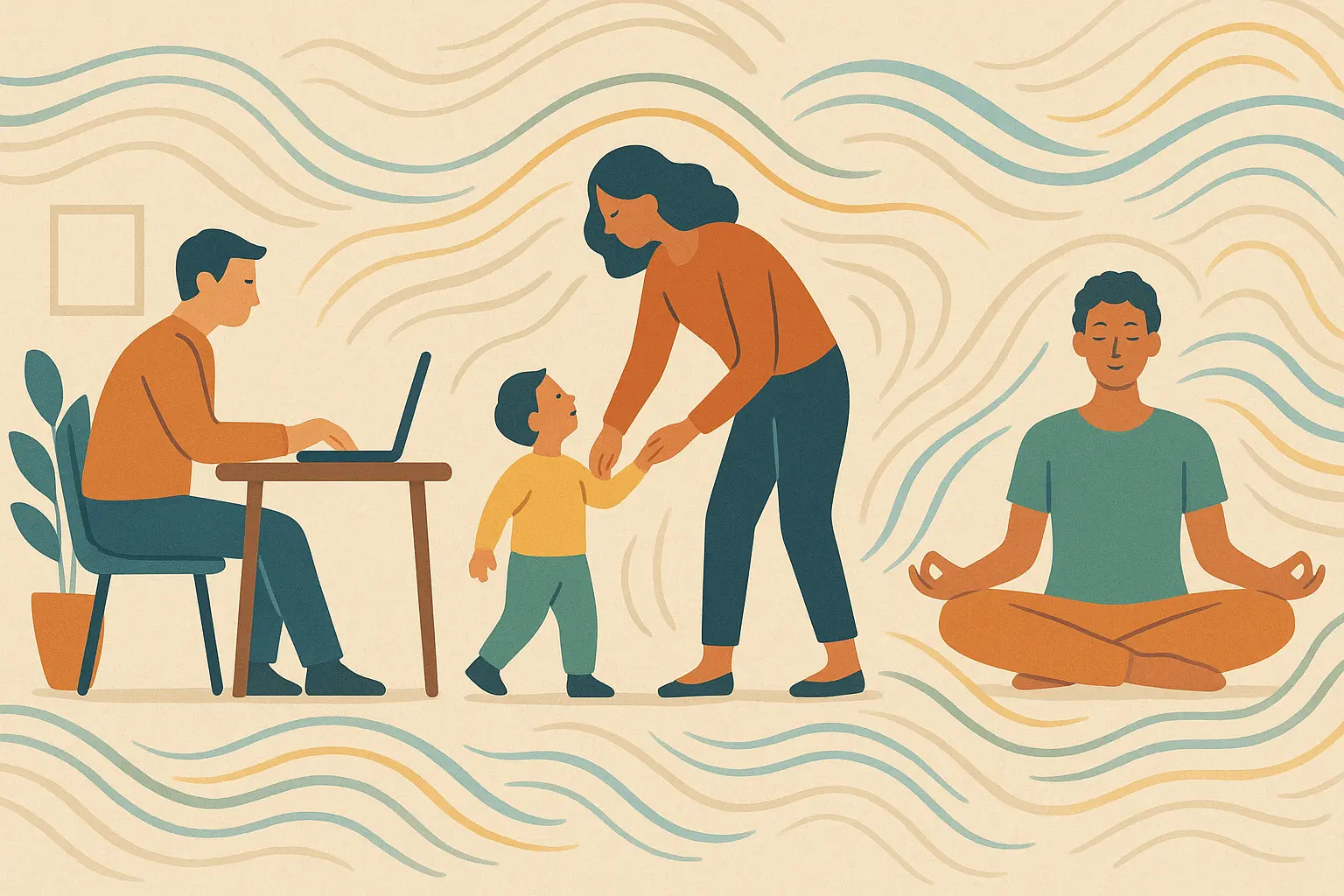
Transform Your Own Storytelling with Ancient Wisdom
Zen stories demonstrate the power of compressed narrative – delivering maximum impact through minimal words. They achieve emotional resonance through concrete imagery rather than abstract concepts, and they leave space for reader interpretation rather than explaining everything explicitly.
These principles align perfectly with modern content creation challenges. Whether you’re crafting social media posts, email newsletters, or longer-form content, zen stories techniques help you cut through noise and create genuine connection with your audience.
The narrative techniques found in these zen stories mirror the principles explored in how to write a story using brain science to create maximum emotional impact through precise storytelling choices.

Nairrate’s AI-powered story generation tools can help you incorporate these timeless principles into your own writing. Just as zen masters used simple stories to convey complex truths, Nairrate helps you find the precise words and narrative structures that resonate with your specific audience.
The zen tradition of “beginner’s mind” – approaching each situation with fresh perspective – mirrors Nairrate’s approach to creative inspiration. When you’re stuck in familiar patterns or struggling with writer’s block, AI-generated story starters can provide the creative catalyst needed to break through limitations.
Ready to channel the narrative precision and emotional depth of zen storytelling into your own creative practice? Nairrate’s Story Starters Generator can help you craft opening lines and narrative frameworks that carry the same clarity and impact as these ancient teachings, bringing together centuries-old wisdom with cutting-edge creative technology.
Final Thoughts
These 25 zen stories offer more than entertainment or philosophical curiosity – they provide practical tools for navigating modern life’s complexities with greater wisdom and peace. Each story addresses specific challenges you face regularly: managing stress and anxiety, handling difficult relationships, finding meaning in work, and accepting life’s inevitable changes.
The beauty of zen stories lies in their simplicity and immediate applicability. You don’t need years of meditation practice or extensive philosophical study to benefit from their wisdom. A single story, understood and applied at the right moment, can shift your entire perspective on a challenging situation.
What makes these particular 25 stories valuable is their proven track record across centuries of human experience. They’ve survived because they work – they consistently help people find clarity, peace, and effective responses to life’s difficulties. Their teachings remain as relevant today as they were hundreds of years ago because they address fundamental aspects of human consciousness and behavior.
The key to gaining value from these stories is active application rather than passive reading. Choose one or two stories that resonate with your current challenges. Practice applying their lessons in real situations. Notice how your responses change when you remember the tea master’s complete attention or the monk’s ability to put down what he’s carrying.
Remember that wisdom develops gradually through consistent practice. These stories plant seeds that grow over time as you encounter various life situations. A story that seems simple today might reveal deeper layers of meaning months or years later when you face different circumstances.
Look, I’m not saying these stories will fix your life. But they might help you feel a little less insane when everything’s falling apart. And honestly, sometimes that’s enough.



Add comment